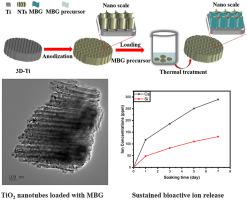当前位置:
X-MOL 学术
›
Prog. Nat. Sci. Mater. Int.
›
论文详情
Our official English website, www.x-mol.net, welcomes your feedback! (Note: you will need to create a separate account there.)
3D printed titanium scaffolds with ordered TiO2 nanotubular surface and mesoporous bioactive glass for bone repair
Progress in Natural Science: Materials International ( IF 4.7 ) Pub Date : 2020-08-01 , DOI: 10.1016/j.pnsc.2020.08.009 Pengyu Zhao , Yaqin Liu , Tian Li , Yanling Zhou , Sander Leeflang , Lei Chen , Chengtie Wu , Jie Zhou , Zhiguang Huan
Progress in Natural Science: Materials International ( IF 4.7 ) Pub Date : 2020-08-01 , DOI: 10.1016/j.pnsc.2020.08.009 Pengyu Zhao , Yaqin Liu , Tian Li , Yanling Zhou , Sander Leeflang , Lei Chen , Chengtie Wu , Jie Zhou , Zhiguang Huan

|
Abstract Titanium alloy scaffolds have recently gained substantial interest for the treatment of critical-size bone defect, particularly along with the maturity of the 3D printing technology that is capable of turning scaffold design ideas into real implants. As titanium alloys lack surface osteogenic activity, for improved biological performance of such scaffolds, surface modification is necessary. Various coating materials and coating methods have been explored. In this study, we developed a unique surface modification method to provide the surface of 3D printed titanium scaffolds with nano-sized structure and bioactive agent. Uniform, ordered TiO2 nanotube arrays were formed by applying two-step anodization, and then mesoporous bioactive glass (MBG) was loaded into nanotubes. The results of in vitro immersion testing showed that bioactive ions, i.e., Si and Ca ions, could be steadily and continuously released from MBG into basal medium. The assessment of the responses of hBMSCs confirmed that the surface-modified scaffolds supported the adhesion and proliferation of hBMSCs, indicating good surface cytocompatibility. The developed method of combining surface nanostructure and bioactive agent could be used as a new strategy to improve the osteogenic activity of 3D printed titanium alloy scaffolds.
中文翻译:

具有有序 TiO2 纳米管表面和介孔生物活性玻璃的 3D 打印钛支架用于骨修复
摘要 钛合金支架最近在治疗临界尺寸骨缺损方面引起了广泛关注,特别是随着 3D 打印技术的成熟,能够将支架设计理念转化为真正的植入物。由于钛合金缺乏表面成骨活性,为了改善这种支架的生物学性能,表面改性是必要的。已经探索了各种涂层材料和涂层方法。在这项研究中,我们开发了一种独特的表面改性方法,为 3D 打印钛支架的表面提供纳米级结构和生物活性剂。通过应用两步阳极氧化形成均匀、有序的 TiO2 纳米管阵列,然后将介孔生物活性玻璃 (MBG) 加载到纳米管中。体外浸泡试验结果表明,生物活性离子、即,Si 和 Ca 离子可以从 MBG 中稳定连续地释放到基础培养基中。对 hBMSCs 反应的评估证实,表面修饰的支架支持 hBMSCs 的粘附和增殖,表明良好的表面细胞相容性。结合表面纳米结构和生物活性剂的开发方法可用作提高 3D 打印钛合金支架成骨活性的新策略。
更新日期:2020-08-01
中文翻译:

具有有序 TiO2 纳米管表面和介孔生物活性玻璃的 3D 打印钛支架用于骨修复
摘要 钛合金支架最近在治疗临界尺寸骨缺损方面引起了广泛关注,特别是随着 3D 打印技术的成熟,能够将支架设计理念转化为真正的植入物。由于钛合金缺乏表面成骨活性,为了改善这种支架的生物学性能,表面改性是必要的。已经探索了各种涂层材料和涂层方法。在这项研究中,我们开发了一种独特的表面改性方法,为 3D 打印钛支架的表面提供纳米级结构和生物活性剂。通过应用两步阳极氧化形成均匀、有序的 TiO2 纳米管阵列,然后将介孔生物活性玻璃 (MBG) 加载到纳米管中。体外浸泡试验结果表明,生物活性离子、即,Si 和 Ca 离子可以从 MBG 中稳定连续地释放到基础培养基中。对 hBMSCs 反应的评估证实,表面修饰的支架支持 hBMSCs 的粘附和增殖,表明良好的表面细胞相容性。结合表面纳米结构和生物活性剂的开发方法可用作提高 3D 打印钛合金支架成骨活性的新策略。



























 京公网安备 11010802027423号
京公网安备 11010802027423号